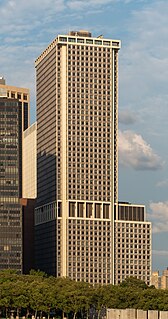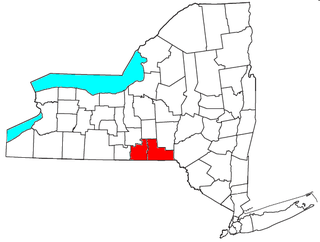
Polychlorinated biphenyls (PCBs) are a highly toxic product whose production was banned by United States federal law in 1978, and by the Stockholm Convention on Persistent Organic Pollutants in 2001. It is an organic chlorine compound with the formula C12H10−xClx. Polychlorinated biphenyls were once widely deployed as dielectric and coolant fluids in electrical apparatus, carbonless copy paper and in heat transfer fluids.

Binghamton is a city in, and the county seat of, Broome County, New York, United States. Surrounded by rolling hills, it lies in the state's Southern Tier region near the Pennsylvania border, in a bowl-shaped valley at the confluence of the Susquehanna and Chenango Rivers. Binghamton is the principal city and cultural center of the Binghamton metropolitan area, home to a quarter million people. The city's population, according to the 2020 census, is 47,969.

The State University of New York at Binghamton is a public research university with campuses in Binghamton, Vestal, and Johnson City, New York. It is one of the four university centers in the State University of New York (SUNY) system. As of Fall 2020, 18,128 undergraduate and graduate students attend the university. The 4-year graduation rate is 72%.

The United States federal Superfund law, officially the Comprehensive Environmental Response, Compensation, and Liability Act of 1980 (CERCLA), established the federal Superfund program, administered by the Environmental Protection Agency (EPA). The program is designed to investigate and clean up sites contaminated with hazardous substances. Sites managed under this program are referred to as "Superfund" sites. There are 40,000 federal Superfund sites across the country, and approximately 1,300 of those sites have been listed on the National Priorities List (NPL). Sites on the NPL are considered the most highly contaminated and undergo longer-term remedial investigation and remedial action (cleanups).

Onondaga Lake is a lake in Central New York, immediately northwest of and adjacent to Syracuse, New York. The southeastern end of the lake and the southwestern shore abut industrial areas and expressways; the northeastern shore and northwestern end border a series of parks and museums.

Marine Midland Bank was a bank formerly headquartered in Buffalo, New York, with several hundred branches throughout the state of New York. In 1998, branches extended to Pennsylvania. It was acquired by HSBC in 1980, and changed its name to HSBC Bank USA in 1999. As a result of several transactions since the turn of the millennium, much of what was once Marine Midland is now part of KeyBank with the exception of Downstate New York and Pennsylvania. that is now part of Citizens Bank.

Commerce Court is an office building complex on King and Bay Streets in the financial district of Toronto, Ontario, Canada. The primary tenant is the Canadian Imperial Bank of Commerce (CIBC) which has its headquarters in the building. The four-building complex is a mix of Art Deco, International, and early Modernism architectural styles.

1 New York Plaza is an office building in the Financial District of Manhattan in New York City, at the intersection of South and Whitehall Streets near South Ferry. The building, measuring 640 feet (200 m) tall with 50 floors, is the southernmost skyscraper in Lower Manhattan. It was designed by William Lescaze & Assocs. and Kahn & Jacobs, and developed by Sol Atlas and John P. McGrath.

The following events occurred in February 1981:

The North Dakota State Capitol is the house of government of the U.S. state of North Dakota. The capitol, a 21-story Art Deco tower, is located in Bismarck at 600 East Boulevard Avenue, and is the tallest habitable building in the state. On a 160-acre (0.6 km2) campus that also houses many other government buildings, the capitol building and the surrounding office buildings house the state's legislative and judicial branches, as well as many government agencies.

Manley Field House is a multi-purpose arena in Syracuse, New York. It is owned and operated by Syracuse University and is located on the Lampe Athletic Complex on university's South campus.

The Binghamton Metropolitan Statistical Area, also called Greater Binghamton or the Triple Cities, is a region of southern Upstate New York in the northeastern United States, anchored by the city of Binghamton. The MSA encompasses Broome and Tioga counties, which together had a population of 247,138 as of the 2020 census. From 1963 to 1983, the MSA also included neighboring Susquehanna County in Pennsylvania, part of which still falls in the Binghamton, NY–PA Urban Area. In addition to these three counties, the greater region includes parts of Delaware and Chenango counties in New York; portions of Cortland and Otsego counties in New York and Wayne County, Pennsylvania are sometimes considered part of the region as well. Using the definition of a 30-mile radius from Binghamton, the population as of the 2010 census is 317,331.

The New York State Department of Environmental Conservation is a department of New York state government. The department guides and regulates the conservation, improvement, and protection of New York's natural resources; manages Forest Preserve lands in the Adirondack and Catskill parks, state forest lands, and wildlife management areas; regulates sport fishing, hunting and trapping; and enforces the state's environmental laws and regulations. Its regulations are compiled in Title 6 of the New York Codes, Rules and Regulations. It was founded in 1970, replacing the Conservation Department. and is headed by Basil Seggos.

The Kin-Buc Landfill is a 220-acre (0.89 km2) Superfund site located in Edison, New Jersey where 70 million US gallons (260,000 m3) of liquid toxic waste and 1 million tons of solid waste were dumped. It was active from the late 1940s to 1976. It was ordered closed in 1977. Cleanup operations have been underway to address environmental issues with contamination from 1980s through to 2000s. This site was one of the largest superfund sites in New Jersey having taken in around 90 million US gallons (340,000 m3). The site is heavily contaminated with PCBs, which leaked into Edmonds Creek, a tributary of the Raritan River.

SUNY Plaza, or the H. Carl McCall SUNY Building, formerly the Delaware & Hudson Railroad Company Building, is a public office building located at 353 Broadway at the intersection with State Street in downtown Albany, New York, United States. Locally the building is sometimes referred to as "The Castle" or "D&H Plaza"; prior to the construction of the nearby Empire State Plaza it was simply "The Plaza". The central tower of the building is thirteen stories high and is capped by an 8-foot-tall (2.4 m) working weathervane that is a replica of Henry Hudson's Half Moon.

The Cedarburg Mill is a former gristmill in Cedarburg, Wisconsin that is listed on the U.S. National Register of Historic Places. Located the on Cedar Creek, the building was constructed in 1855 by Frederick Hilgen and William Schroeder to replace a smaller wooden mill from the 1840s. At the time of its construction, the five-story structure was the tallest building in Cedarburg.
State Office Building may refer to:
The Syracuse and Binghamton Railroad was established on August 18, 1851, and opened for business on October 18, 1854. The road merged in 1856 into Syracuse and Southern Railroad which was renamed to Syracuse, Binghamton and New York Railroad when the company reorganized after foreclosure in 1857.

Between 1947 and 1977, General Electric polluted the Hudson River by discharging polychlorinated biphenyls (PCBs) causing a range of harmful effects to wildlife and people who eat fish from the river. Other kinds of pollution, including mercury contamination and cities discharging untreated sewage, have also caused problems in the river.

The Theatre Row Building is a complex of five Off-Broadway theatres at 410 West 42nd Street on Theatre Row in Hell's Kitchen, Manhattan, New York City. The building is owned by the 501(c)(3) organization non-profit Building for the Arts and is the center piece of an effort to transform the adult entertainment district on 42nd Street between Ninth Avenue and Tenth Avenue into an Off-Broadway theater district.


















